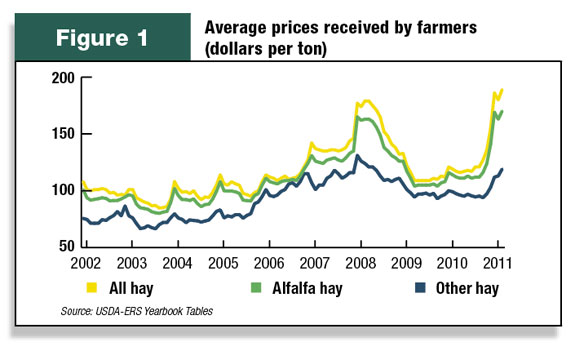A quick look at the current hay market reports from the USDA (see page 38) shows hay prices in most areas have sky-rocketed over the last few months. Although there is some debate about how accurate those reports are, it’s pretty obvious that prices are on the rise.
A cool, wet spring in some areas, summer drought in others and other feed commodity acreage or prices are all influencing the upward trend.
Not surprisingly, the most recent USDA-NASS Crop Production report shows large hay production reductions.
For example, hay production in 2011 in Texas now looks to be about half of 2010 levels. Nationally, alfalfa hay production will be down at least 4 percent overall.
USDA also estimates other hay production this year will be 14 percent or 10.7 million tons below a year ago.
According to the Livestock Marketing Information Center forecasts, hay prices nationally will be record-high this year, with all types of hay averaging about 50 percent above a year ago.
While this is obviously great news for those selling hay, there’s always a give-and-take in situations like this.
While forage producers may be realizing great profits this year, animal producers, on the other hand, are struggling. Feed prices across the spectrum are high, while milk and dairy prices are not keeping up.
What does this mean for next year and looking into the future? While nobody knows for sure what will happen, I except we’ll see a slight increase in forage acres and hopefully, if Mother Nature will cooperate, an increase in productivity, as well.
The current high prices for hay, silage and even pasture ground are not sustainable. While I understand the law of supply and demand, forage producers need something to eat their crops.

If we have a huge decrease in animal numbers because of unrealistic feed prices, forage prices will also take a drastic drop, and then we enter the cycle all over again (see Figure 1, which shows the up-and-down nature of forage production).
I would encourage producers on both sides of the coin to work together in the coming months to keep everyone in business.
Those who will be selling forage – don’t undersell, but don’t charge unreasonably high prices either. Be business-smart and get signed contacts, but be willing to work with your buyers in a realistic manner.
Animal producers – be fair with your forage suppliers. Don’t enter into a contract if you know you won’t be able to pay. Communicate clearly your needs and expectations. And show appreciation from sellers that are willing to work with you.
Hopefully we can all get through the next few months and figure out where we’re going from there.
Editor’s note: After writing an editorial about paying attention to the details, I’m a little red in the face to admit an error in the precipitation outlooks on page 31 of our last issue. I appreciate some sharp-eyed readers that called to point out the information didn’t make sense.
I regret my error in placing the temperature rather than the precipitation outlooks on those two maps. It has been corrected in this issue, but I sure wish it had better news for our friends and producers, particularly in the Southwest. Our thoughts and prayers are with all of those suffering from severe weather conditions across the country.









